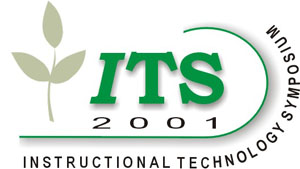| Distance Education Plant Pathology
Courses at the University of Georgia
Elizabeth L. Little
Department of Plant Pathology,
University of Georgia
Athens, GA 30602
U. S. A.
|
 |
Introduction
Agriculturists, such as consultants,
managers, and extension agents, often find that they need advanced degrees
to keep pace with the rapid changes in their area of specialization. However,
they generally cannot attend regular campus classes. The Master of Plant
Protection and Pest Management (MPPPM), a non-thesis degree program at
the University of Georgia (UGA), is a logical choice for many who are seeking
comprehensive, multi-disciplinary training in crop production and crop
protection. Therefore, the MPPPM program was targeted for conversion to
a distance education format.
Two Plant Pathology courses were the
first to be converted to a distance education format: 1) Introductory Plant
Pathology; and 2) Diagnosis and Management of Plant Diseases. Diagnosis
and Management is one of the core curricula courses for the MPPPM degree.
Introductory Plant Pathology is a prerequisite for the Diagnosis and Management
course. In addition, both courses would be attractive to students in the
private sector and in other colleges in the Southeast who desire to learn
the basic principles and applications of plant pathology. Introductory
Plant Pathology was converted to a distance education format and taught
in the Spring of 2000. Diagnosis and Management followed in the Fall of
2000. Students consisted mainly of county extension agents and research
personnel at the experiment stations.
Methods
The distance education version of these
courses was the same in credit and content as the courses taught on campus.
The WebCT program, a limited-access
instructional resource application, was the primary method to deliver the
content for both courses. WebCT features include:
1. Path editor for delivering
course material in modules
2. Bulletin board for discussions
3. Private mail for student/instructor
communication
4. Glossary with links to the path
editor
5. Image gallery
6. On-line quiz
7. Chat
8. Area for posting grades
An interactive video network (GSAMS),
with connections to each county in the state, was used in the Introductory
Plant Pathology course to supplement the course material and to provide
face-to-face interaction with the students.
Hands-on laboratory sessions were an
essential part of both courses. Up to five mandatory half-day lab sessions
were conducted during the semester. In addition, some exercises were performed
independently by the students and kits were provided to students for pathogen
isolations and transfers. The distance diagnostics system, administered
by the Cooperative Extension Service allowed students to send images of
symptoms and signs to the instructor for consultation or to the bulletin
board for sharing with the other students.
Proctored exams were either administered
during lab periods or at another arranged time.
Results
The following observations were made
based on course evaluations and student comments:
1. Students were able to master
the technology needed to participate in the on-line course material, although
students who had limited computer skills had more difficulties initially.
The greatest obstacle to the on-line delivery of information was the low
capacity of the connections for transmission of information. Most students
were still using analog modems to connect to the internet. Large or numerous
images, as well as multiple links, do not work well under these circumstances.
2. Students varied in the ease with
which they adapted to the distance education style of learning. Distance
education involves more independent learning and students must have enough
self-discipline to find the time in their schedules for the course. In
general, older students adapted more easily and actually preferred the
flexibility. Many of the students had been exposed to agronomic problems
as part of their jobs and these students were especially enthusiastic about
learning the practical aspects of plant pathology and were eager to share
their field experiences in bulletin board discussions. A few students never
adapted well to distance education and were more comfortable with traditional
classroom lectures. Active learning through mandatory discussion sessions,
on-line quizzes, and a problem-solving approach was important in keeping
the students engaged and learning. While these techniques are useful in
all learning situations, for on-line learning they are essential.
3. The hands-on laboratory sessions
were the greatest challenge in teaching distance plant pathology courses.
For the Introductory Plant Pathology course, students found that there
was too much material condensed into each lab session. The Diagnosis and
Management of Plant Diseases course was particularly challenging due to
the extensive hands-on time students need to learn the plant disease diagnosing
techniques. University extension personnel were particularly helpful in
working with the students individually.
Future Directions
This first year of teaching distance
education classes was as much of a learning experience for the instructor
as for the students. The goal now is to incorporate the following changes
in future offerings of these courses:
1. The course content as well
as images of diseases and pathogen structures would be more accessible
and useful to the students if incorporated into a CD that the students
could use anytime without connecting to the internet.
2. Mandatory weekly discussion sessions,
question sets incorporating a problem-solving approach, and quizzes would
still be presented over the WebCT but would become a more frequent and
dominant part of the course.
3. Independent laboratory modules for
the Introductory Plant Pathology course would be developed although group
lab sessions would not be entirely omitted. Satellite labs could be established
with the cooperation of other institutions around the state as locations
where students could use the equipment needed to perform the laboratory
modules.
4. An extended and intensive field
trip at the beginning of the semester would be incorporated into the Diagnosis
and Management course. Students would spend several days traveling through
the state collecting disease specimens, observing cropping systems, and
learning the techniques for diagnosis. The students would then have the
skills necessary to compile their independent disease collections as part
of the course requirements.
End
| 